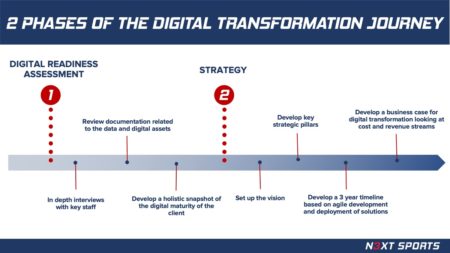Can your organization stay relevant without going through a digital transformation process? According to PwC, 78.4% of Sports organizations will increase funding and efforts to accelerate digital transformation. The question many have is where to start?
N3XT Sports supports clients by first completing a digital readiness assessment which is followed by a digital transformation strategy for a period of 2 to 3 years. We conducted these two steps on behalf of a Basketball Club in 2020. Read on to better understand the steps involved and let us know if your organization would benefit from this approach.

Phase 1: Digital Readiness Assessment
To take the first step in evaluating the digital readiness of our client, we conducted in-depth interviews with key staff from digital, marketing, ticketing, commercial, operations, IT, and the executive leadership team to have an objective 360 view of the club’s existing digital & data context. This included looking at things from the operational side of the business such as the structure and flow of data, the use of data by 3rd parties, ownership of that data, the CRM in place. We also took a deep dive into the fan- and partner-facing digital & data assets, such as the responsiveness & performance of mobile and web applications, data consolidation, ticketing, and event management modules.
After conducting these interviews, we reviewed all the documentation related to the data & digital assets, such as contracts, technology specifications, user manuals, and licenses. By this point, we were able to develop a holistic snapshot of the digital maturity of the client. This was delivered in a personalized report focusing on 9 technical & business pillars. It included the current digital & data architecture and specific recommendations on how to progress on the customer relationship management (CRM), venue management, data collection, and ticketing.
This was delivered to the club’s leadership, as well as the marketing and IT teams. During this step, we expanded the presentation and knowledge sharing to include macro trends in the sports industry around digital transformation, emerging business models & new stakeholders entering the sports industry. Through this process, the leadership and management of the club was able to have a common understanding and vision for digital transformation.
Phase 2: Strategy
Prioritizing the expenditure on digital transformation is the next step of the process. This is done by developing a detailed digital transformation strategy that aligns digital transformation with the corporate strategy.
Essentially, this strategy identifies how digital & data will achieve the corporate objectives. It also details the timeline for how resources will be deployed and the timeline for development of digital & data assets. Importantly, it also identifies the future-state digital & data architecture that must be reached.
To come up with such a comprehensive digital strategy, we worked with the client to organize workshops focused on defining a clear digital vision for the club, including its operational, business & financial objectives for digital. Once the digital vision of the club was set, we developed a set of strategic pillars that were needed to bring the plan to life.
Once the digital vision and the strategic pillars were set, we focused on developing a 3-year timeline based on agile development and deployment of solutions. This made it possible to estimate the budgets needed for the digital transformation process. At this point, we co-created a governance & decision making structure that took into account the different stakeholders involved, including commercial partners, and the KPIs that would be tracked throughout the process.
The next step of the strategy phase was to develop a business case for digital transformation that looked at the costs and revenue streams. From the costs side, we looked at the types of platforms that would be used, their lifetime costs, how they fit in with the future digital & data architecture. This also included personnel costs, use of external contractors, vendors and suppliers. On the revenue side, we looked at things such as new sponsorship assets, engagement and conversion of audiences, e-commerce, ticketing, content subscriptions, and looked at how it could refresh the commercial portfolio of the club.
Equipped with this digital strategy, the club was able to align its digital transformation with its corporate strategy over the next three years. Importantly, the club had a clear path to implementation that outlined costs, revenues, decision making, and personnel involved.
BY PRIORITIZING DIGITAL TRANSFORMATION YOU MAXIMIZE BENEFITS MOVING FORWARD
“Now is the right time to prioritize digital transformation within sports organizations. More specifically, it means delivering on digital while also transforming into a digital organization. You can clearly see the organizations within the sports industry and beyond that have already invested in their digital foundation. They are able to produce new content, personalize it, and deliver value to commercial partners, and generate new revenue streams.“
Success stories like this one are becoming more and more common, and yours should be one of them. With understanding and commitment from your organization’s leadership team, the proper culture within your organization, and a clear vision of the corporate strategy, you can start your digital transformation journey.
In doing so, you will build a proper digital and data foundation in place to stay relevant and rapidly adapt to any unprecedented circumstances.
Thinking about embarking into your digital transformation journey? Fill out this form and we will reach out to you as soon as possible.


